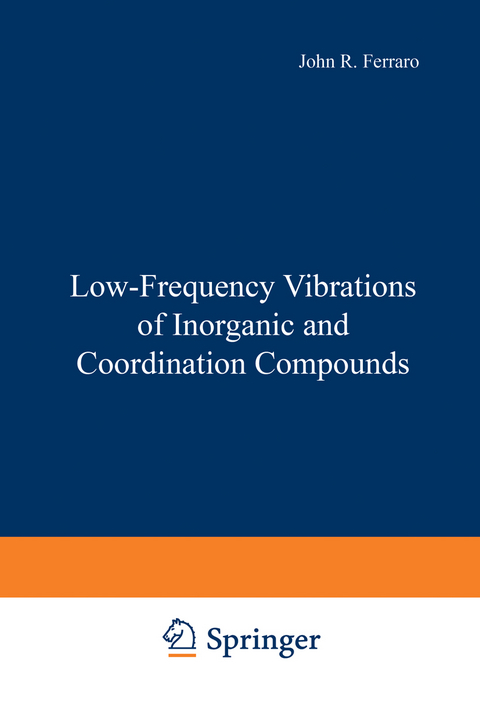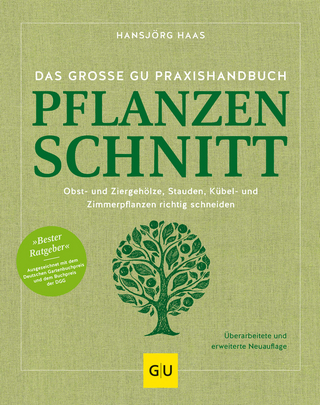
Low-Frequency Vibrations of Inorganic and Coordination Compounds
Springer-Verlag New York Inc.
978-1-4684-1811-8 (ISBN)
1 Introduction.- 1.1. History.- 1.2. Usefulness of the Far-Infrared Region.- 1.3. Problems and Remedies.- 2 Far-Infrared Instrumentation.- 2.1. Introduction.- 2.2. Present Commercial Grating/Prism Instruments.- 2.3. Present Commercial Interferometric Instruments.- 2.4. Comparison of the Interferometer with the Conventional Spectrometer.- 2.5. Trends in Far-Infrared Instrumentation.- 3 Sampling Techniques and Instrument Calibration in the Far-Infrared Region.- 3.1. Introduction.- 3.2. Window Materials for Cells.- 3.3. Far-Infrared Solvents.- 3.4. Sampling Techniques.- 3.5. Calibration of Far-Infrared Instruments.- 4 New Techniques Used with Far-Infrared Measurements.- 4.1. Introduction.- 4.2. The Slow-Neutron Scattering (SNS) Technique.- 4.3. High-Pressure Techniques in the Far-Infrared Region.- 5 Metal-Oxygen Vibrations.- 5.1. Metal-Oxygen Vibrations in Hydrates.- 5.2. Metallic Oxides.- 5.3. Metal-Oxygen Vibrations in Hydroxyl-Bridged Complexes.- 5.4. Metal-Oxygen Vibrations in Salts Involving Oxygenated Polyatomic Anions.- 5.5. ?-Diketone Complexes.- 5.6. Complexes of Organic Acids.- 5.7. Complexes of Organic Oxide Ligands.- 5.8. Miscellaneous Complexes.- 5.9. Nature of the Metal-Oxygen Vibration.- 5.10. Raman Spectroscopic Studies.- 6 Metal-Halide Vibration.- 6.1. Introduction.- 6.2. Hepta- and Octacoordinated Molecules—MX7, MX8 (CN = 7, 8).- 6.3. Hexacoordinated Molecules—Oh Symmetry (CN = 6).- 6.4. Pentacoordinated Molecules—MX5, MX5n- (CN = 5).- 6.5. Tetracoordinated Molecules—MX4, MX4n- (CN = 4).- 6.6. Tricoordinated Molecules—MX3 (CN = 3).- 6.7. Dicoordinated Molecules—MX2 (CN = 2).- 6.8. MX-Type Metal Halides.- 6.9. Miscellaneous Metal Halide Vibrations.- 6.10. Complexes Involving Organic Ligands.- 6.11. Bridged Metal Halide Vibrations.- 6.12.Summary.- 7 Metal-Nitrogen Vibration.- 7.1. Introduction.- 7.2. Metal Ammine Complexes.- 7.3. Complexes of 2,2?-Bipyridyl, 2,2?,2?-Terpyridyl, 1,10-Phenanthroline, Aniline, and 8-Aminoquinoline.- 7.4. Metal-Imidazole Complexes and Complexes with Substituted Imidazoles.- 7.5. Metal-Pyridine and Related Complexes.- 7.6. Metal-Ethylenediamine and Related Complexes.- 7.7. Metal-Hydrazine Complexes.- 7.8. Metal Complexes Containing Nitrile Groups.- 7.9. Metal Isothiocyanate and Related Complexes.- 7.10. Metal-Amino Acid Complexes.- 7.11. Metal-Nitro Complexes.- 7.12. Metal-Azide Complexes.- 7.13. Metal-Nitrosyl Complexes.- 7.14. Summary.- 8 Miscellaneous Metal-Ligand Vibrations.- 8.1. Introduction.- 8.2. Metal-Sulfur Vibrations.- 8.3. Metal-Selenium Vibrations.- 8.4. Metal-Tellurium Vibrations.- 8.5. Metal-Phosphorus Vibrations.- 8.6. Metal-Arsenic Vibrations.- 8.7. Metal-Metal Vibrations.- 8.8. Summary of the ?MC and ?MCX Vibrations.- 9 Other Low-Frequency Vibrations.- 9.1. Ion-Pair Vibrations.- 9.2. Low-Frequency Vibrations of Molecules Trapped in Clathrates.- 9.3. Electronic Transitions.- 9.4. Lattice Vibrations.- 9.5. Miscellaneous Vibrations.- Appendixes.- Appendix 1. Selection Rules and Correlation Charts.- Site Symmetries for the 230 Space Groups.- Correlation Tables for the Species of a Group and Its Subgroups.- Appendix 2. Procedure Used for Factor Group Analysis of Solids.
| Zusatzinfo | XIV, 310 p. |
|---|---|
| Verlagsort | New York, NY |
| Sprache | englisch |
| Maße | 152 x 229 mm |
| Themenwelt | Sachbuch/Ratgeber ► Natur / Technik ► Garten |
| Naturwissenschaften ► Chemie ► Anorganische Chemie | |
| ISBN-10 | 1-4684-1811-4 / 1468418114 |
| ISBN-13 | 978-1-4684-1811-8 / 9781468418118 |
| Zustand | Neuware |
| Haben Sie eine Frage zum Produkt? |
aus dem Bereich


